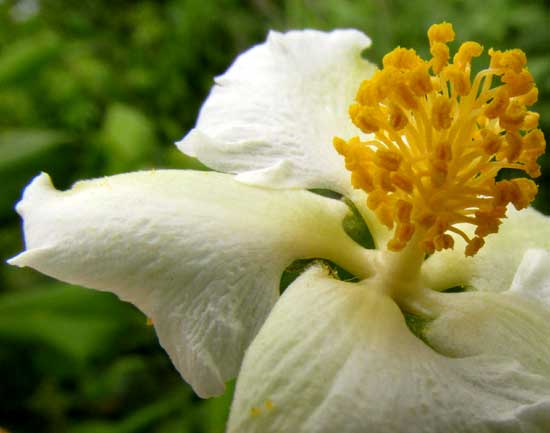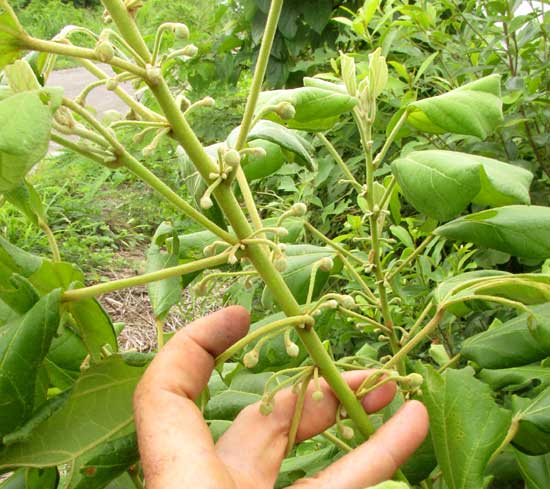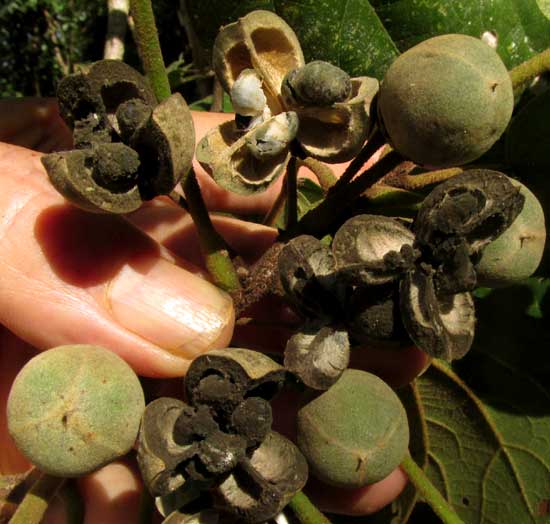Excerpts from Jim Conrad's
Naturalist Newsletter
from the September 3, 2017 Newsletter issued from Rancho Regenesis in the woods ±4kms west of Ek Balam Ruins; elevation ~40m (~130 ft), N20.876°, W88.170°; north-central Yucatán, MÉXICO
HAMPEA TREE FLOWERING
Atop the little mound on which the new concrete water tower has been built there rises a 20ft tall (6m) tree with a slender, gray trunk, and bearing white flowers. The blossoms look like little white tea-roses among the tree's unusually large, three-lobed leaves with droopy sides, as shown below:

Even from a distance the small tree looked like a member of the Hibiscus Family, because of its leaves, which displayed conspicuous veins arising from the blades' bases -- as opposed to there being just a single prominent midrib, as with most leaves. Also, the long petioles were covered with a thick mat of brownish hairs. These are traits shared by many Hibiscus Family members.
When one side of a flower was broken away so that its sexual parts were easier to see, the tree's membership in the Hibiscus Family was confirmed, as evidenced below:

The detail corroborating Hibiscus Family membership was that the flower's numerous stamens were united at their filaments' bases, forming a cylinder around the style. In the above picture, the style -- the ovary's "neck" -- is the darkish item thrusting up from the bouquet of yellow stamens. The style is topped with a grainy-textured, curving stigma, which is where pollen grains are supposed to land and germinate.
With these field marks I could identify our little tree as HAMPEA TRILOBATA, endemic just to the Yucatan Peninsula and neighboring Belize and northern Guatemala. It has no English name, but Hampea is good enough. Despite its limited distribution, in this area the species is fairly common, often growing along weedy roadsides, but also in thin soil atop limestone rises.
When reading about the species I was surprised to find it described as "dioecious," meaning that trees bear either unisexual male or female flowers, but not both flower types on the same plant. That explained why the stamens at the base of the vigorous-looking style in the above picture looked a bit puny. Now I went looking for Hampeas with male flowers, and they were easy to find along a weedy road. A male flower with a much more robust-looking bunch of stamens, but with no indication of a style, is shown below:

Once I began paying attention to different Hampea plants I realized that the 20ft tall tree in the woods atop our mound was a little atypical for the species. By far the greatest number of Hampea plants here are best described as bushes or weedy shrubs. Below, you can see what most of our Hampeas look like, this one bearing many flower buds on crook-necked pedicels, but not yet flowering:

The excellent online Biblioteca Digital de la Medicina Tradicional Mexicana reports Hampea being used medicinally to treat wasp stings. It says that the roots are chewed, though it's unclear whether the stung individual chews the roots, or the doctor, who spits root juice onto the sting. Hampea also is used to treat the evil eye, or mal de ojo, which among the Maya is possibly the most commonly reported ailment, along with bad winds. The Biblioteca Digital website, produced by UNAM, the Autonomous University of Mexico, is freely available at http://www.medicinatradicionalmexicana.unam.mx
from the December 31, 2017 Newsletter issued from Rancho Regenesis in the woods ±4kms west of Ek Balam Ruins; elevation ~40m (~130 ft), N20.876°, W88.170°; north-central Yucatán, MÉXICO
HAMPEA TREE FRUITING
Nowadays our Hampeas are producing fruits, a cluster of which is shown below:

Notice the neatness with which the capsules open into three parts, each cell bearing a seed. Most of the seeds in this group of opened fruits are blackened with what appears to be a fungus. Notice that the fruit closest to the image's right border has been been gnawed on and partially opened, possibly by a squirrel. The exposed seed in that fruit is blackened, so a good guess is that the other black seeds were contaminated with fungal growth through similar breaks in their fruit's husk, maybe by worms.